Solid State Fermentation: Applications, Advantages, and Challenges
VerifiedAdded on 2022/09/22
|68
|23539
|28
Report
AI Summary
This report provides a comprehensive overview of Solid State Fermentation (SSF), a crucial process in biotechnology, particularly in agriculture and pharmaceuticals. It explores the fundamental concepts of SSF, emphasizing its advantages over liquid-based fermentation, such as reduced wastewater and cost-effectiveness. The report delves into the application of SSF in various industries, including enzyme production, waste management, and food processing. It examines the critical parameters influencing SSF, including substrate selection, microorganism utilization, reactor design, and environmental factors like temperature and moisture. The report also addresses the economic aspects of SSF, evaluating cost-effective procedures and analyzing the impact of different factors on the cost-benefit ratio. It highlights the potential of SSF in reducing waste volume and its role in sustainable practices. The study encompasses a systematic review of existing literature and provides insights into the current utilization of SSF, its potential advantages, and limitations, offering a valuable resource for students and researchers in the field.
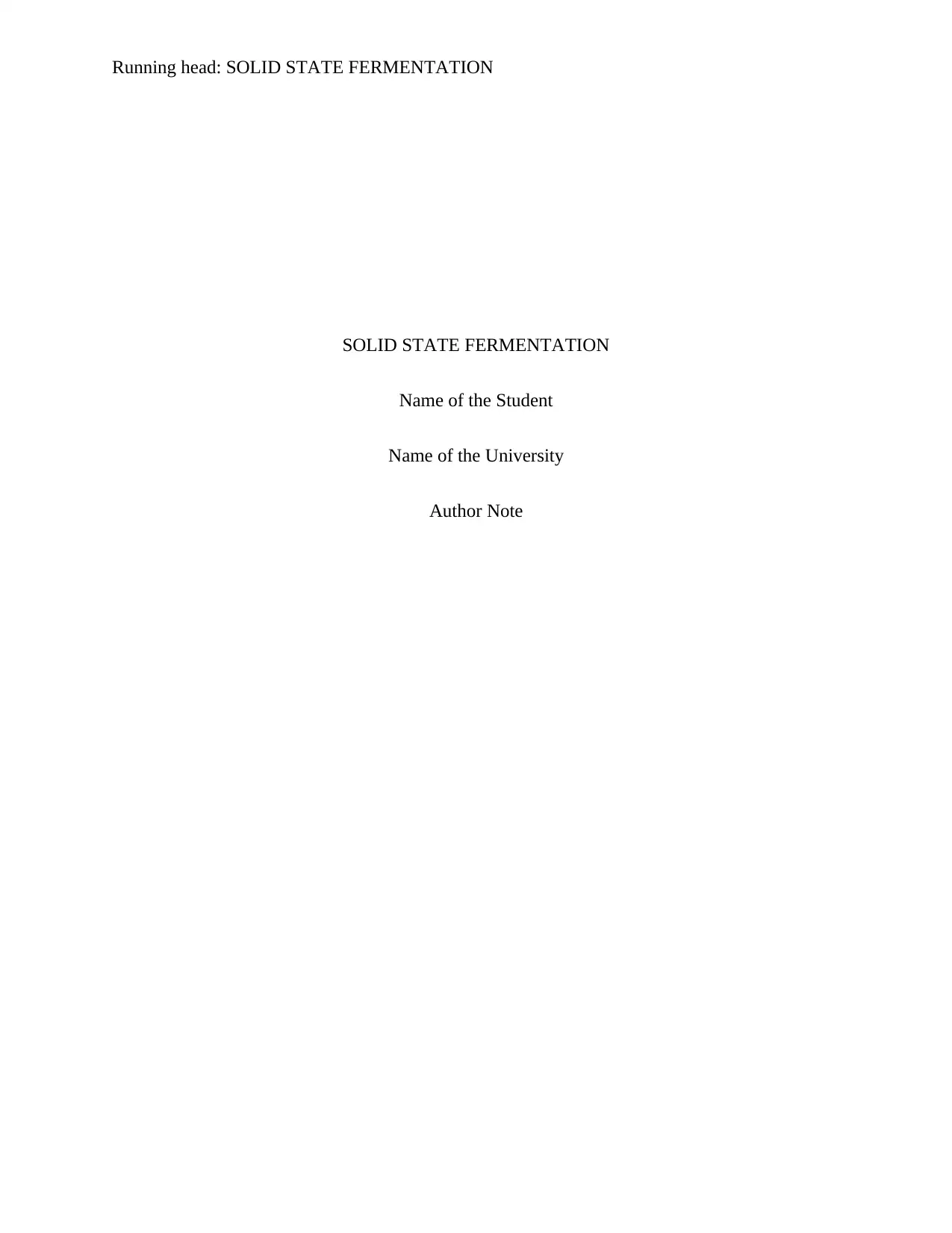
Running head: SOLID STATE FERMENTATION
SOLID STATE FERMENTATION
Name of the Student
Name of the University
Author Note
SOLID STATE FERMENTATION
Name of the Student
Name of the University
Author Note
Paraphrase This Document
Need a fresh take? Get an instant paraphrase of this document with our AI Paraphraser
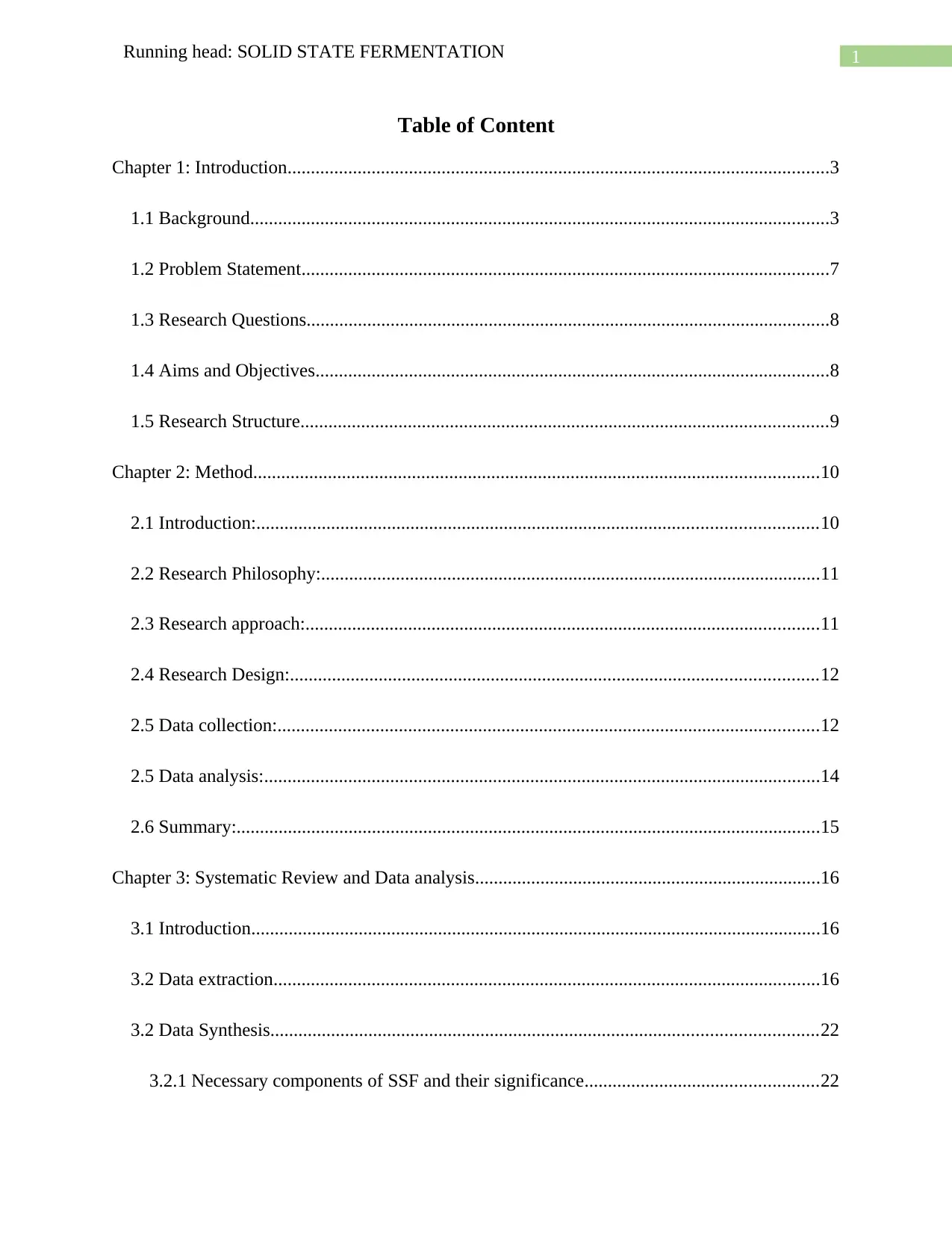
1Running head: SOLID STATE FERMENTATION
Table of Content
Chapter 1: Introduction....................................................................................................................3
1.1 Background............................................................................................................................3
1.2 Problem Statement.................................................................................................................7
1.3 Research Questions................................................................................................................8
1.4 Aims and Objectives..............................................................................................................8
1.5 Research Structure.................................................................................................................9
Chapter 2: Method.........................................................................................................................10
2.1 Introduction:........................................................................................................................10
2.2 Research Philosophy:...........................................................................................................11
2.3 Research approach:..............................................................................................................11
2.4 Research Design:.................................................................................................................12
2.5 Data collection:....................................................................................................................12
2.5 Data analysis:.......................................................................................................................14
2.6 Summary:.............................................................................................................................15
Chapter 3: Systematic Review and Data analysis..........................................................................16
3.1 Introduction..........................................................................................................................16
3.2 Data extraction.....................................................................................................................16
3.2 Data Synthesis.....................................................................................................................22
3.2.1 Necessary components of SSF and their significance..................................................22
Table of Content
Chapter 1: Introduction....................................................................................................................3
1.1 Background............................................................................................................................3
1.2 Problem Statement.................................................................................................................7
1.3 Research Questions................................................................................................................8
1.4 Aims and Objectives..............................................................................................................8
1.5 Research Structure.................................................................................................................9
Chapter 2: Method.........................................................................................................................10
2.1 Introduction:........................................................................................................................10
2.2 Research Philosophy:...........................................................................................................11
2.3 Research approach:..............................................................................................................11
2.4 Research Design:.................................................................................................................12
2.5 Data collection:....................................................................................................................12
2.5 Data analysis:.......................................................................................................................14
2.6 Summary:.............................................................................................................................15
Chapter 3: Systematic Review and Data analysis..........................................................................16
3.1 Introduction..........................................................................................................................16
3.2 Data extraction.....................................................................................................................16
3.2 Data Synthesis.....................................................................................................................22
3.2.1 Necessary components of SSF and their significance..................................................22
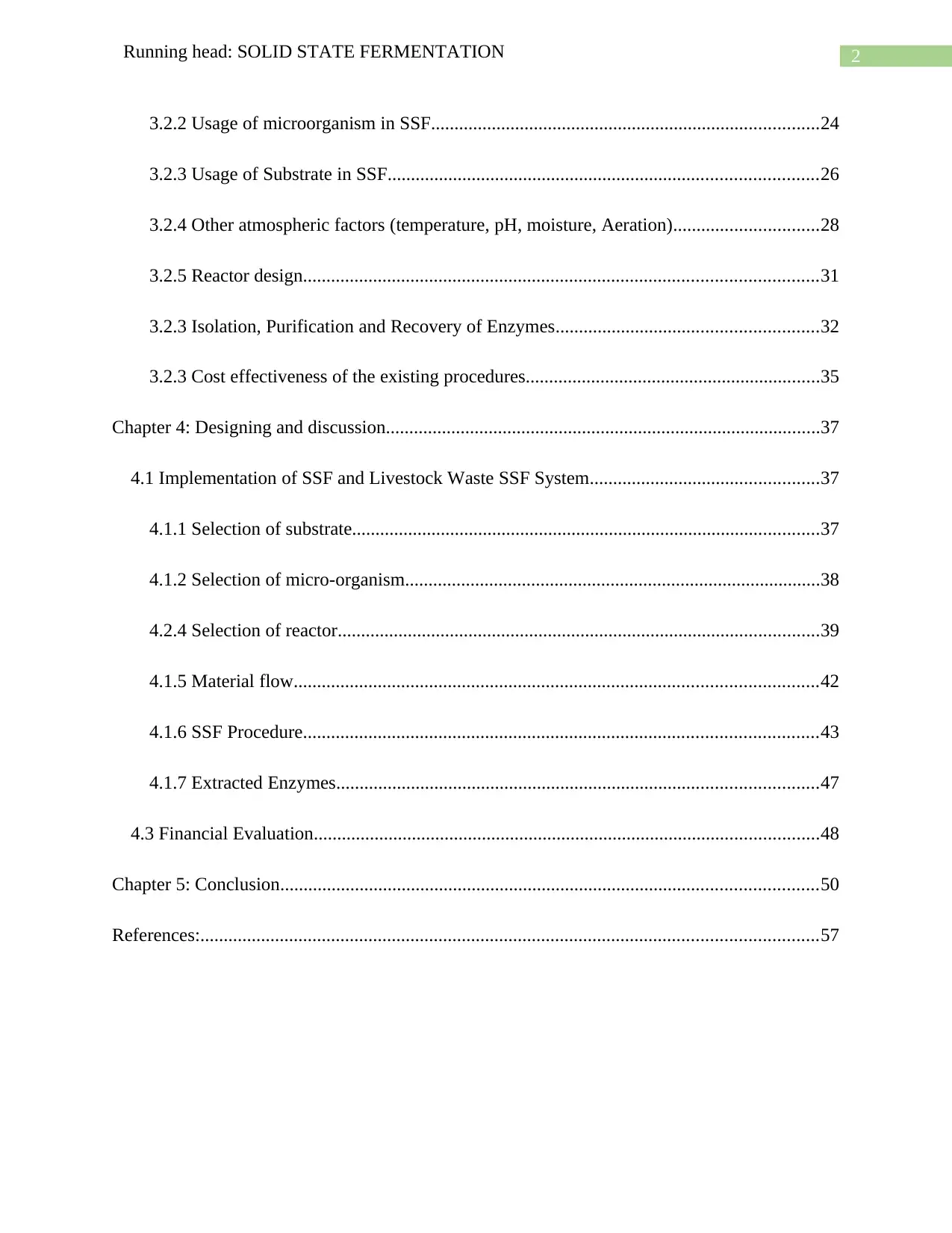
2Running head: SOLID STATE FERMENTATION
3.2.2 Usage of microorganism in SSF...................................................................................24
3.2.3 Usage of Substrate in SSF............................................................................................26
3.2.4 Other atmospheric factors (temperature, pH, moisture, Aeration)...............................28
3.2.5 Reactor design..............................................................................................................31
3.2.3 Isolation, Purification and Recovery of Enzymes........................................................32
3.2.3 Cost effectiveness of the existing procedures...............................................................35
Chapter 4: Designing and discussion.............................................................................................37
4.1 Implementation of SSF and Livestock Waste SSF System.................................................37
4.1.1 Selection of substrate....................................................................................................37
4.1.2 Selection of micro-organism.........................................................................................38
4.2.4 Selection of reactor.......................................................................................................39
4.1.5 Material flow................................................................................................................42
4.1.6 SSF Procedure..............................................................................................................43
4.1.7 Extracted Enzymes.......................................................................................................47
4.3 Financial Evaluation............................................................................................................48
Chapter 5: Conclusion...................................................................................................................50
References:....................................................................................................................................57
3.2.2 Usage of microorganism in SSF...................................................................................24
3.2.3 Usage of Substrate in SSF............................................................................................26
3.2.4 Other atmospheric factors (temperature, pH, moisture, Aeration)...............................28
3.2.5 Reactor design..............................................................................................................31
3.2.3 Isolation, Purification and Recovery of Enzymes........................................................32
3.2.3 Cost effectiveness of the existing procedures...............................................................35
Chapter 4: Designing and discussion.............................................................................................37
4.1 Implementation of SSF and Livestock Waste SSF System.................................................37
4.1.1 Selection of substrate....................................................................................................37
4.1.2 Selection of micro-organism.........................................................................................38
4.2.4 Selection of reactor.......................................................................................................39
4.1.5 Material flow................................................................................................................42
4.1.6 SSF Procedure..............................................................................................................43
4.1.7 Extracted Enzymes.......................................................................................................47
4.3 Financial Evaluation............................................................................................................48
Chapter 5: Conclusion...................................................................................................................50
References:....................................................................................................................................57
⊘ This is a preview!⊘
Do you want full access?
Subscribe today to unlock all pages.

Trusted by 1+ million students worldwide
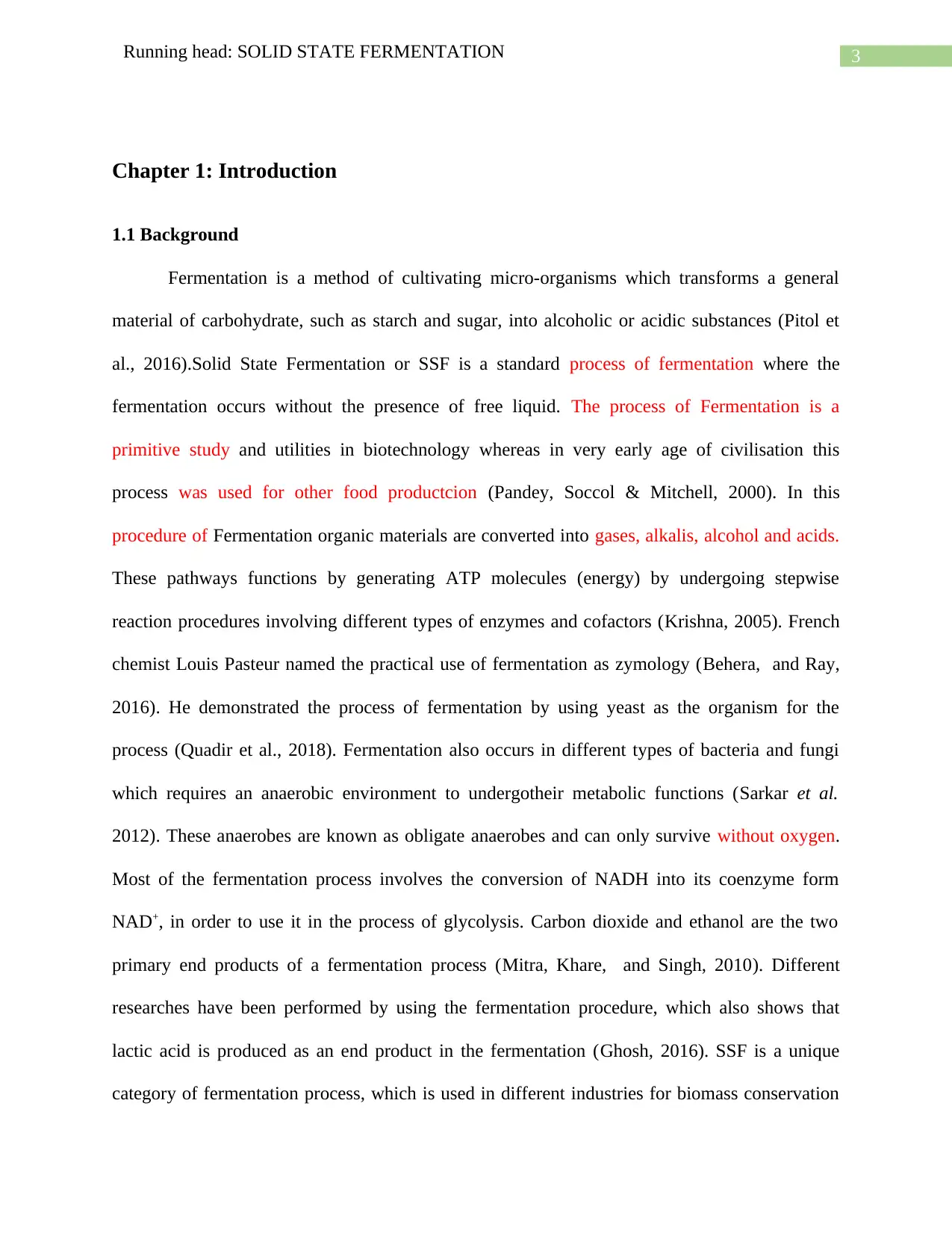
3Running head: SOLID STATE FERMENTATION
Chapter 1: Introduction
1.1 Background
Fermentation is a method of cultivating micro-organisms which transforms a general
material of carbohydrate, such as starch and sugar, into alcoholic or acidic substances (Pitol et
al., 2016).Solid State Fermentation or SSF is a standard process of fermentation where the
fermentation occurs without the presence of free liquid. The process of Fermentation is a
primitive study and utilities in biotechnology whereas in very early age of civilisation this
process was used for other food productcion (Pandey, Soccol & Mitchell, 2000). In this
procedure of Fermentation organic materials are converted into gases, alkalis, alcohol and acids.
These pathways functions by generating ATP molecules (energy) by undergoing stepwise
reaction procedures involving different types of enzymes and cofactors (Krishna, 2005). French
chemist Louis Pasteur named the practical use of fermentation as zymology (Behera, and Ray,
2016). He demonstrated the process of fermentation by using yeast as the organism for the
process (Quadir et al., 2018). Fermentation also occurs in different types of bacteria and fungi
which requires an anaerobic environment to undergotheir metabolic functions (Sarkar et al.
2012). These anaerobes are known as obligate anaerobes and can only survive without oxygen.
Most of the fermentation process involves the conversion of NADH into its coenzyme form
NAD+, in order to use it in the process of glycolysis. Carbon dioxide and ethanol are the two
primary end products of a fermentation process (Mitra, Khare, and Singh, 2010). Different
researches have been performed by using the fermentation procedure, which also shows that
lactic acid is produced as an end product in the fermentation (Ghosh, 2016). SSF is a unique
category of fermentation process, which is used in different industries for biomass conservation
Chapter 1: Introduction
1.1 Background
Fermentation is a method of cultivating micro-organisms which transforms a general
material of carbohydrate, such as starch and sugar, into alcoholic or acidic substances (Pitol et
al., 2016).Solid State Fermentation or SSF is a standard process of fermentation where the
fermentation occurs without the presence of free liquid. The process of Fermentation is a
primitive study and utilities in biotechnology whereas in very early age of civilisation this
process was used for other food productcion (Pandey, Soccol & Mitchell, 2000). In this
procedure of Fermentation organic materials are converted into gases, alkalis, alcohol and acids.
These pathways functions by generating ATP molecules (energy) by undergoing stepwise
reaction procedures involving different types of enzymes and cofactors (Krishna, 2005). French
chemist Louis Pasteur named the practical use of fermentation as zymology (Behera, and Ray,
2016). He demonstrated the process of fermentation by using yeast as the organism for the
process (Quadir et al., 2018). Fermentation also occurs in different types of bacteria and fungi
which requires an anaerobic environment to undergotheir metabolic functions (Sarkar et al.
2012). These anaerobes are known as obligate anaerobes and can only survive without oxygen.
Most of the fermentation process involves the conversion of NADH into its coenzyme form
NAD+, in order to use it in the process of glycolysis. Carbon dioxide and ethanol are the two
primary end products of a fermentation process (Mitra, Khare, and Singh, 2010). Different
researches have been performed by using the fermentation procedure, which also shows that
lactic acid is produced as an end product in the fermentation (Ghosh, 2016). SSF is a unique
category of fermentation process, which is used in different industries for biomass conservation
Paraphrase This Document
Need a fresh take? Get an instant paraphrase of this document with our AI Paraphraser
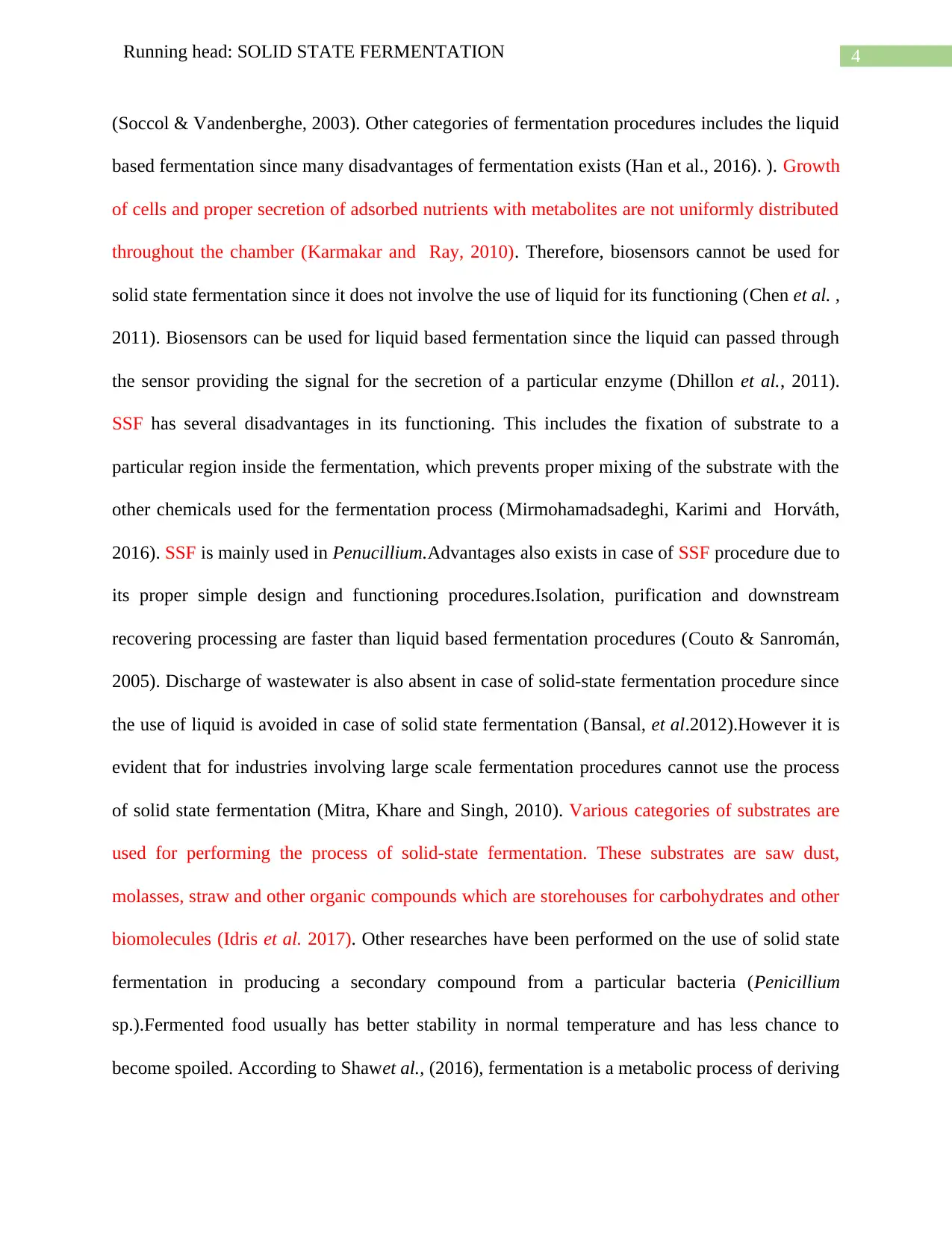
4Running head: SOLID STATE FERMENTATION
(Soccol & Vandenberghe, 2003). Other categories of fermentation procedures includes the liquid
based fermentation since many disadvantages of fermentation exists (Han et al., 2016). ). Growth
of cells and proper secretion of adsorbed nutrients with metabolites are not uniformly distributed
throughout the chamber (Karmakar and Ray, 2010). Therefore, biosensors cannot be used for
solid state fermentation since it does not involve the use of liquid for its functioning (Chen et al. ,
2011). Biosensors can be used for liquid based fermentation since the liquid can passed through
the sensor providing the signal for the secretion of a particular enzyme (Dhillon et al., 2011).
SSF has several disadvantages in its functioning. This includes the fixation of substrate to a
particular region inside the fermentation, which prevents proper mixing of the substrate with the
other chemicals used for the fermentation process (Mirmohamadsadeghi, Karimi and Horváth,
2016). SSF is mainly used in Penucillium.Advantages also exists in case of SSF procedure due to
its proper simple design and functioning procedures.Isolation, purification and downstream
recovering processing are faster than liquid based fermentation procedures (Couto & Sanromán,
2005). Discharge of wastewater is also absent in case of solid-state fermentation procedure since
the use of liquid is avoided in case of solid state fermentation (Bansal, et al.2012).However it is
evident that for industries involving large scale fermentation procedures cannot use the process
of solid state fermentation (Mitra, Khare and Singh, 2010). Various categories of substrates are
used for performing the process of solid-state fermentation. These substrates are saw dust,
molasses, straw and other organic compounds which are storehouses for carbohydrates and other
biomolecules (Idris et al. 2017). Other researches have been performed on the use of solid state
fermentation in producing a secondary compound from a particular bacteria (Penicillium
sp.).Fermented food usually has better stability in normal temperature and has less chance to
become spoiled. According to Shawet al., (2016), fermentation is a metabolic process of deriving
(Soccol & Vandenberghe, 2003). Other categories of fermentation procedures includes the liquid
based fermentation since many disadvantages of fermentation exists (Han et al., 2016). ). Growth
of cells and proper secretion of adsorbed nutrients with metabolites are not uniformly distributed
throughout the chamber (Karmakar and Ray, 2010). Therefore, biosensors cannot be used for
solid state fermentation since it does not involve the use of liquid for its functioning (Chen et al. ,
2011). Biosensors can be used for liquid based fermentation since the liquid can passed through
the sensor providing the signal for the secretion of a particular enzyme (Dhillon et al., 2011).
SSF has several disadvantages in its functioning. This includes the fixation of substrate to a
particular region inside the fermentation, which prevents proper mixing of the substrate with the
other chemicals used for the fermentation process (Mirmohamadsadeghi, Karimi and Horváth,
2016). SSF is mainly used in Penucillium.Advantages also exists in case of SSF procedure due to
its proper simple design and functioning procedures.Isolation, purification and downstream
recovering processing are faster than liquid based fermentation procedures (Couto & Sanromán,
2005). Discharge of wastewater is also absent in case of solid-state fermentation procedure since
the use of liquid is avoided in case of solid state fermentation (Bansal, et al.2012).However it is
evident that for industries involving large scale fermentation procedures cannot use the process
of solid state fermentation (Mitra, Khare and Singh, 2010). Various categories of substrates are
used for performing the process of solid-state fermentation. These substrates are saw dust,
molasses, straw and other organic compounds which are storehouses for carbohydrates and other
biomolecules (Idris et al. 2017). Other researches have been performed on the use of solid state
fermentation in producing a secondary compound from a particular bacteria (Penicillium
sp.).Fermented food usually has better stability in normal temperature and has less chance to
become spoiled. According to Shawet al., (2016), fermentation is a metabolic process of deriving
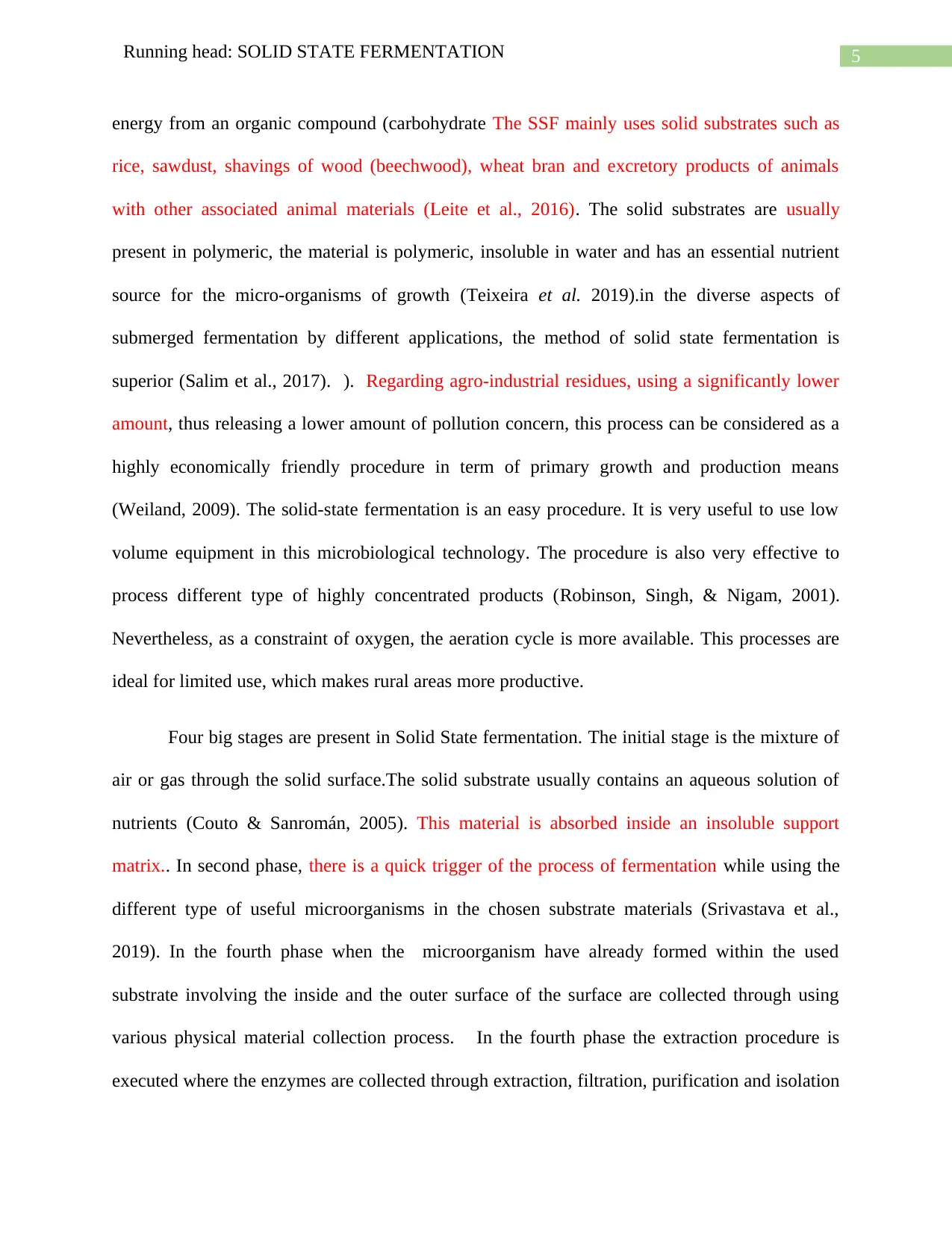
5Running head: SOLID STATE FERMENTATION
energy from an organic compound (carbohydrate The SSF mainly uses solid substrates such as
rice, sawdust, shavings of wood (beechwood), wheat bran and excretory products of animals
with other associated animal materials (Leite et al., 2016). The solid substrates are usually
present in polymeric, the material is polymeric, insoluble in water and has an essential nutrient
source for the micro-organisms of growth (Teixeira et al. 2019).in the diverse aspects of
submerged fermentation by different applications, the method of solid state fermentation is
superior (Salim et al., 2017). ). Regarding agro-industrial residues, using a significantly lower
amount, thus releasing a lower amount of pollution concern, this process can be considered as a
highly economically friendly procedure in term of primary growth and production means
(Weiland, 2009). The solid-state fermentation is an easy procedure. It is very useful to use low
volume equipment in this microbiological technology. The procedure is also very effective to
process different type of highly concentrated products (Robinson, Singh, & Nigam, 2001).
Nevertheless, as a constraint of oxygen, the aeration cycle is more available. This processes are
ideal for limited use, which makes rural areas more productive.
Four big stages are present in Solid State fermentation. The initial stage is the mixture of
air or gas through the solid surface.The solid substrate usually contains an aqueous solution of
nutrients (Couto & Sanromán, 2005). This material is absorbed inside an insoluble support
matrix.. In second phase, there is a quick trigger of the process of fermentation while using the
different type of useful microorganisms in the chosen substrate materials (Srivastava et al.,
2019). In the fourth phase when the microorganism have already formed within the used
substrate involving the inside and the outer surface of the surface are collected through using
various physical material collection process. In the fourth phase the extraction procedure is
executed where the enzymes are collected through extraction, filtration, purification and isolation
energy from an organic compound (carbohydrate The SSF mainly uses solid substrates such as
rice, sawdust, shavings of wood (beechwood), wheat bran and excretory products of animals
with other associated animal materials (Leite et al., 2016). The solid substrates are usually
present in polymeric, the material is polymeric, insoluble in water and has an essential nutrient
source for the micro-organisms of growth (Teixeira et al. 2019).in the diverse aspects of
submerged fermentation by different applications, the method of solid state fermentation is
superior (Salim et al., 2017). ). Regarding agro-industrial residues, using a significantly lower
amount, thus releasing a lower amount of pollution concern, this process can be considered as a
highly economically friendly procedure in term of primary growth and production means
(Weiland, 2009). The solid-state fermentation is an easy procedure. It is very useful to use low
volume equipment in this microbiological technology. The procedure is also very effective to
process different type of highly concentrated products (Robinson, Singh, & Nigam, 2001).
Nevertheless, as a constraint of oxygen, the aeration cycle is more available. This processes are
ideal for limited use, which makes rural areas more productive.
Four big stages are present in Solid State fermentation. The initial stage is the mixture of
air or gas through the solid surface.The solid substrate usually contains an aqueous solution of
nutrients (Couto & Sanromán, 2005). This material is absorbed inside an insoluble support
matrix.. In second phase, there is a quick trigger of the process of fermentation while using the
different type of useful microorganisms in the chosen substrate materials (Srivastava et al.,
2019). In the fourth phase when the microorganism have already formed within the used
substrate involving the inside and the outer surface of the surface are collected through using
various physical material collection process. In the fourth phase the extraction procedure is
executed where the enzymes are collected through extraction, filtration, purification and isolation
⊘ This is a preview!⊘
Do you want full access?
Subscribe today to unlock all pages.

Trusted by 1+ million students worldwide
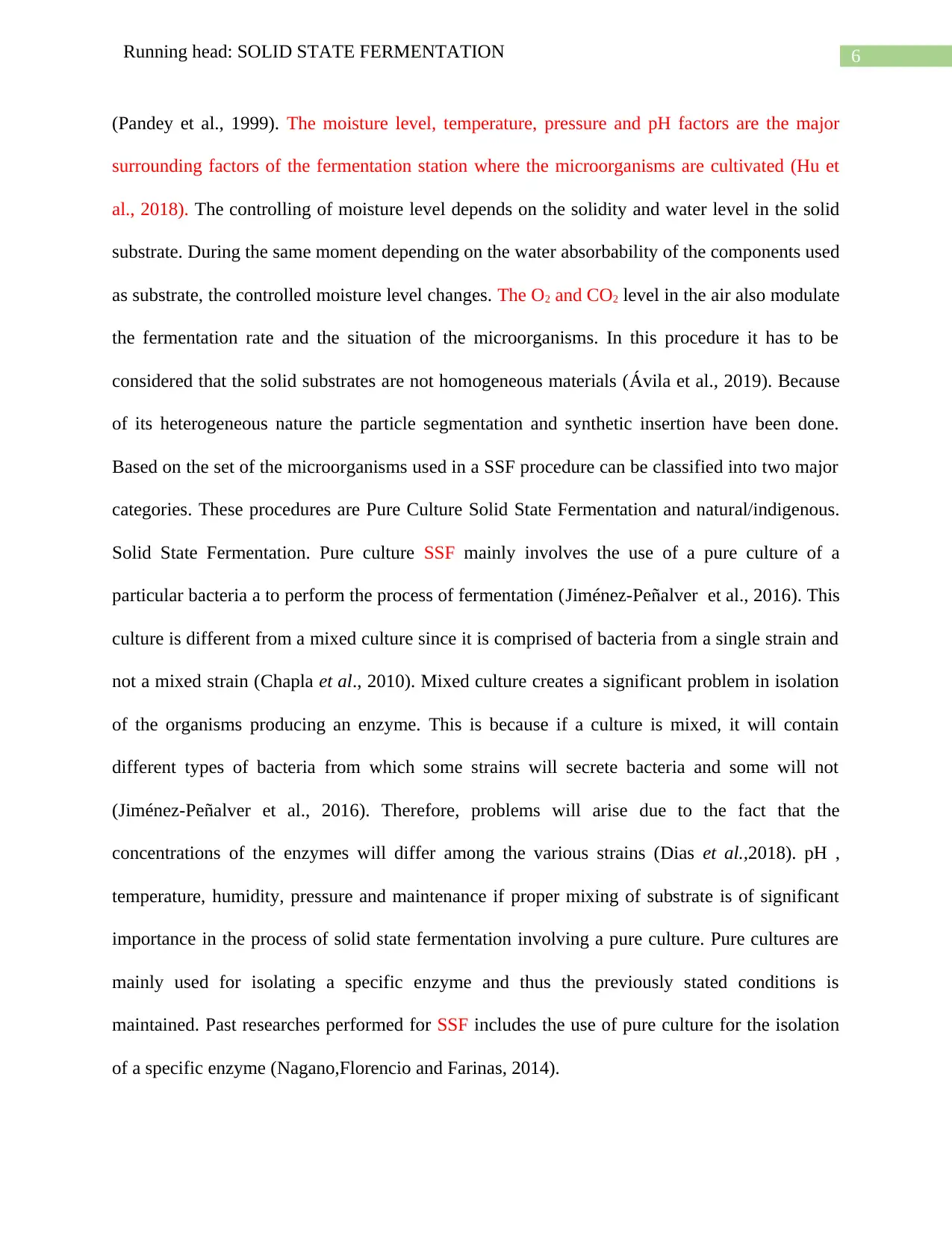
6Running head: SOLID STATE FERMENTATION
(Pandey et al., 1999). The moisture level, temperature, pressure and pH factors are the major
surrounding factors of the fermentation station where the microorganisms are cultivated (Hu et
al., 2018). The controlling of moisture level depends on the solidity and water level in the solid
substrate. During the same moment depending on the water absorbability of the components used
as substrate, the controlled moisture level changes. The O2 and CO2 level in the air also modulate
the fermentation rate and the situation of the microorganisms. In this procedure it has to be
considered that the solid substrates are not homogeneous materials (Ávila et al., 2019). Because
of its heterogeneous nature the particle segmentation and synthetic insertion have been done.
Based on the set of the microorganisms used in a SSF procedure can be classified into two major
categories. These procedures are Pure Culture Solid State Fermentation and natural/indigenous.
Solid State Fermentation. Pure culture SSF mainly involves the use of a pure culture of a
particular bacteria a to perform the process of fermentation (Jiménez-Peñalver et al., 2016). This
culture is different from a mixed culture since it is comprised of bacteria from a single strain and
not a mixed strain (Chapla et al., 2010). Mixed culture creates a significant problem in isolation
of the organisms producing an enzyme. This is because if a culture is mixed, it will contain
different types of bacteria from which some strains will secrete bacteria and some will not
(Jiménez-Peñalver et al., 2016). Therefore, problems will arise due to the fact that the
concentrations of the enzymes will differ among the various strains (Dias et al.,2018). pH ,
temperature, humidity, pressure and maintenance if proper mixing of substrate is of significant
importance in the process of solid state fermentation involving a pure culture. Pure cultures are
mainly used for isolating a specific enzyme and thus the previously stated conditions is
maintained. Past researches performed for SSF includes the use of pure culture for the isolation
of a specific enzyme (Nagano,Florencio and Farinas, 2014).
(Pandey et al., 1999). The moisture level, temperature, pressure and pH factors are the major
surrounding factors of the fermentation station where the microorganisms are cultivated (Hu et
al., 2018). The controlling of moisture level depends on the solidity and water level in the solid
substrate. During the same moment depending on the water absorbability of the components used
as substrate, the controlled moisture level changes. The O2 and CO2 level in the air also modulate
the fermentation rate and the situation of the microorganisms. In this procedure it has to be
considered that the solid substrates are not homogeneous materials (Ávila et al., 2019). Because
of its heterogeneous nature the particle segmentation and synthetic insertion have been done.
Based on the set of the microorganisms used in a SSF procedure can be classified into two major
categories. These procedures are Pure Culture Solid State Fermentation and natural/indigenous.
Solid State Fermentation. Pure culture SSF mainly involves the use of a pure culture of a
particular bacteria a to perform the process of fermentation (Jiménez-Peñalver et al., 2016). This
culture is different from a mixed culture since it is comprised of bacteria from a single strain and
not a mixed strain (Chapla et al., 2010). Mixed culture creates a significant problem in isolation
of the organisms producing an enzyme. This is because if a culture is mixed, it will contain
different types of bacteria from which some strains will secrete bacteria and some will not
(Jiménez-Peñalver et al., 2016). Therefore, problems will arise due to the fact that the
concentrations of the enzymes will differ among the various strains (Dias et al.,2018). pH ,
temperature, humidity, pressure and maintenance if proper mixing of substrate is of significant
importance in the process of solid state fermentation involving a pure culture. Pure cultures are
mainly used for isolating a specific enzyme and thus the previously stated conditions is
maintained. Past researches performed for SSF includes the use of pure culture for the isolation
of a specific enzyme (Nagano,Florencio and Farinas, 2014).
Paraphrase This Document
Need a fresh take? Get an instant paraphrase of this document with our AI Paraphraser
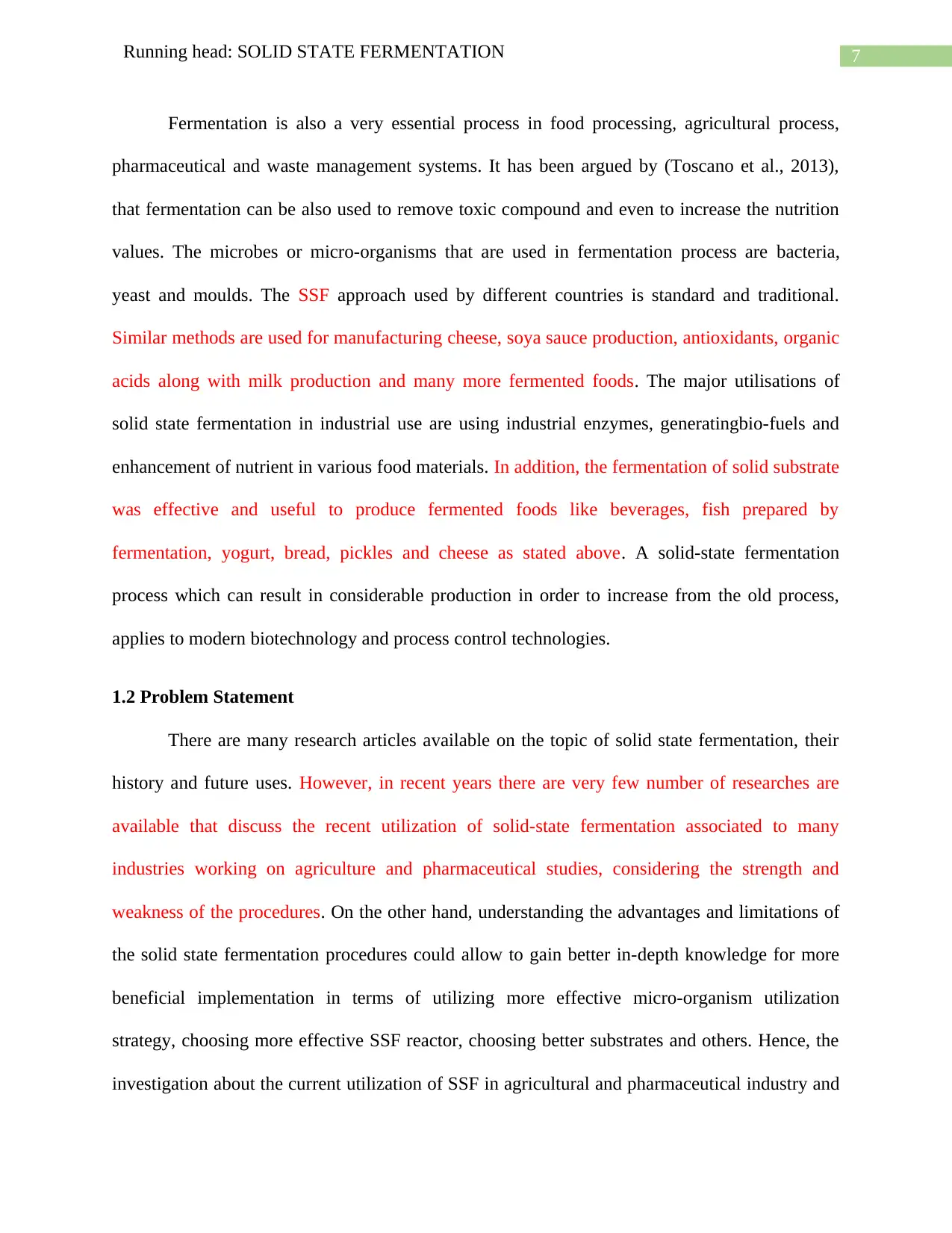
7Running head: SOLID STATE FERMENTATION
Fermentation is also a very essential process in food processing, agricultural process,
pharmaceutical and waste management systems. It has been argued by (Toscano et al., 2013),
that fermentation can be also used to remove toxic compound and even to increase the nutrition
values. The microbes or micro-organisms that are used in fermentation process are bacteria,
yeast and moulds. The SSF approach used by different countries is standard and traditional.
Similar methods are used for manufacturing cheese, soya sauce production, antioxidants, organic
acids along with milk production and many more fermented foods. The major utilisations of
solid state fermentation in industrial use are using industrial enzymes, generatingbio-fuels and
enhancement of nutrient in various food materials. In addition, the fermentation of solid substrate
was effective and useful to produce fermented foods like beverages, fish prepared by
fermentation, yogurt, bread, pickles and cheese as stated above. A solid-state fermentation
process which can result in considerable production in order to increase from the old process,
applies to modern biotechnology and process control technologies.
1.2 Problem Statement
There are many research articles available on the topic of solid state fermentation, their
history and future uses. However, in recent years there are very few number of researches are
available that discuss the recent utilization of solid-state fermentation associated to many
industries working on agriculture and pharmaceutical studies, considering the strength and
weakness of the procedures. On the other hand, understanding the advantages and limitations of
the solid state fermentation procedures could allow to gain better in-depth knowledge for more
beneficial implementation in terms of utilizing more effective micro-organism utilization
strategy, choosing more effective SSF reactor, choosing better substrates and others. Hence, the
investigation about the current utilization of SSF in agricultural and pharmaceutical industry and
Fermentation is also a very essential process in food processing, agricultural process,
pharmaceutical and waste management systems. It has been argued by (Toscano et al., 2013),
that fermentation can be also used to remove toxic compound and even to increase the nutrition
values. The microbes or micro-organisms that are used in fermentation process are bacteria,
yeast and moulds. The SSF approach used by different countries is standard and traditional.
Similar methods are used for manufacturing cheese, soya sauce production, antioxidants, organic
acids along with milk production and many more fermented foods. The major utilisations of
solid state fermentation in industrial use are using industrial enzymes, generatingbio-fuels and
enhancement of nutrient in various food materials. In addition, the fermentation of solid substrate
was effective and useful to produce fermented foods like beverages, fish prepared by
fermentation, yogurt, bread, pickles and cheese as stated above. A solid-state fermentation
process which can result in considerable production in order to increase from the old process,
applies to modern biotechnology and process control technologies.
1.2 Problem Statement
There are many research articles available on the topic of solid state fermentation, their
history and future uses. However, in recent years there are very few number of researches are
available that discuss the recent utilization of solid-state fermentation associated to many
industries working on agriculture and pharmaceutical studies, considering the strength and
weakness of the procedures. On the other hand, understanding the advantages and limitations of
the solid state fermentation procedures could allow to gain better in-depth knowledge for more
beneficial implementation in terms of utilizing more effective micro-organism utilization
strategy, choosing more effective SSF reactor, choosing better substrates and others. Hence, the
investigation about the current utilization of SSF in agricultural and pharmaceutical industry and
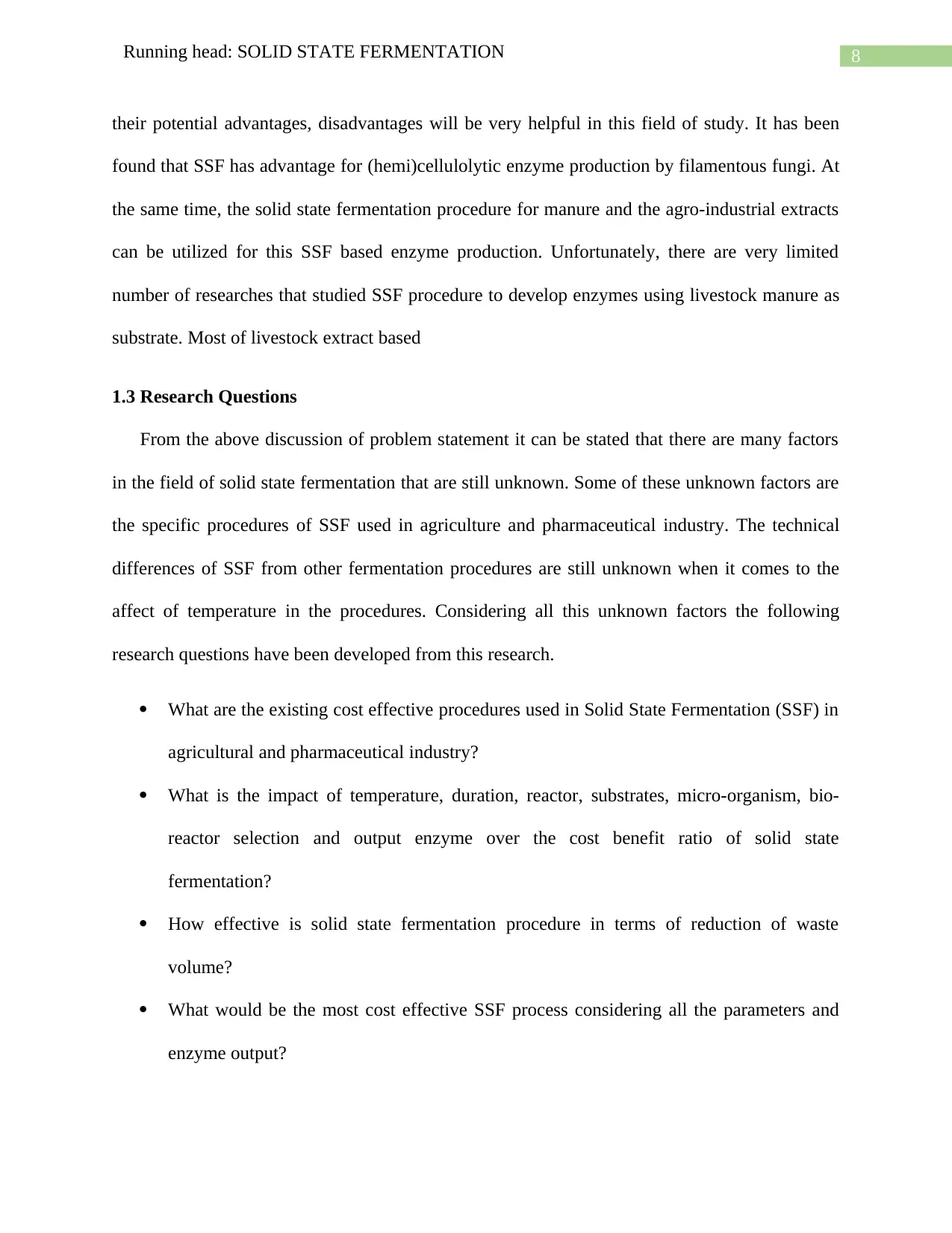
8Running head: SOLID STATE FERMENTATION
their potential advantages, disadvantages will be very helpful in this field of study. It has been
found that SSF has advantage for (hemi)cellulolytic enzyme production by filamentous fungi. At
the same time, the solid state fermentation procedure for manure and the agro-industrial extracts
can be utilized for this SSF based enzyme production. Unfortunately, there are very limited
number of researches that studied SSF procedure to develop enzymes using livestock manure as
substrate. Most of livestock extract based
1.3 Research Questions
From the above discussion of problem statement it can be stated that there are many factors
in the field of solid state fermentation that are still unknown. Some of these unknown factors are
the specific procedures of SSF used in agriculture and pharmaceutical industry. The technical
differences of SSF from other fermentation procedures are still unknown when it comes to the
affect of temperature in the procedures. Considering all this unknown factors the following
research questions have been developed from this research.
What are the existing cost effective procedures used in Solid State Fermentation (SSF) in
agricultural and pharmaceutical industry?
What is the impact of temperature, duration, reactor, substrates, micro-organism, bio-
reactor selection and output enzyme over the cost benefit ratio of solid state
fermentation?
How effective is solid state fermentation procedure in terms of reduction of waste
volume?
What would be the most cost effective SSF process considering all the parameters and
enzyme output?
their potential advantages, disadvantages will be very helpful in this field of study. It has been
found that SSF has advantage for (hemi)cellulolytic enzyme production by filamentous fungi. At
the same time, the solid state fermentation procedure for manure and the agro-industrial extracts
can be utilized for this SSF based enzyme production. Unfortunately, there are very limited
number of researches that studied SSF procedure to develop enzymes using livestock manure as
substrate. Most of livestock extract based
1.3 Research Questions
From the above discussion of problem statement it can be stated that there are many factors
in the field of solid state fermentation that are still unknown. Some of these unknown factors are
the specific procedures of SSF used in agriculture and pharmaceutical industry. The technical
differences of SSF from other fermentation procedures are still unknown when it comes to the
affect of temperature in the procedures. Considering all this unknown factors the following
research questions have been developed from this research.
What are the existing cost effective procedures used in Solid State Fermentation (SSF) in
agricultural and pharmaceutical industry?
What is the impact of temperature, duration, reactor, substrates, micro-organism, bio-
reactor selection and output enzyme over the cost benefit ratio of solid state
fermentation?
How effective is solid state fermentation procedure in terms of reduction of waste
volume?
What would be the most cost effective SSF process considering all the parameters and
enzyme output?
⊘ This is a preview!⊘
Do you want full access?
Subscribe today to unlock all pages.

Trusted by 1+ million students worldwide
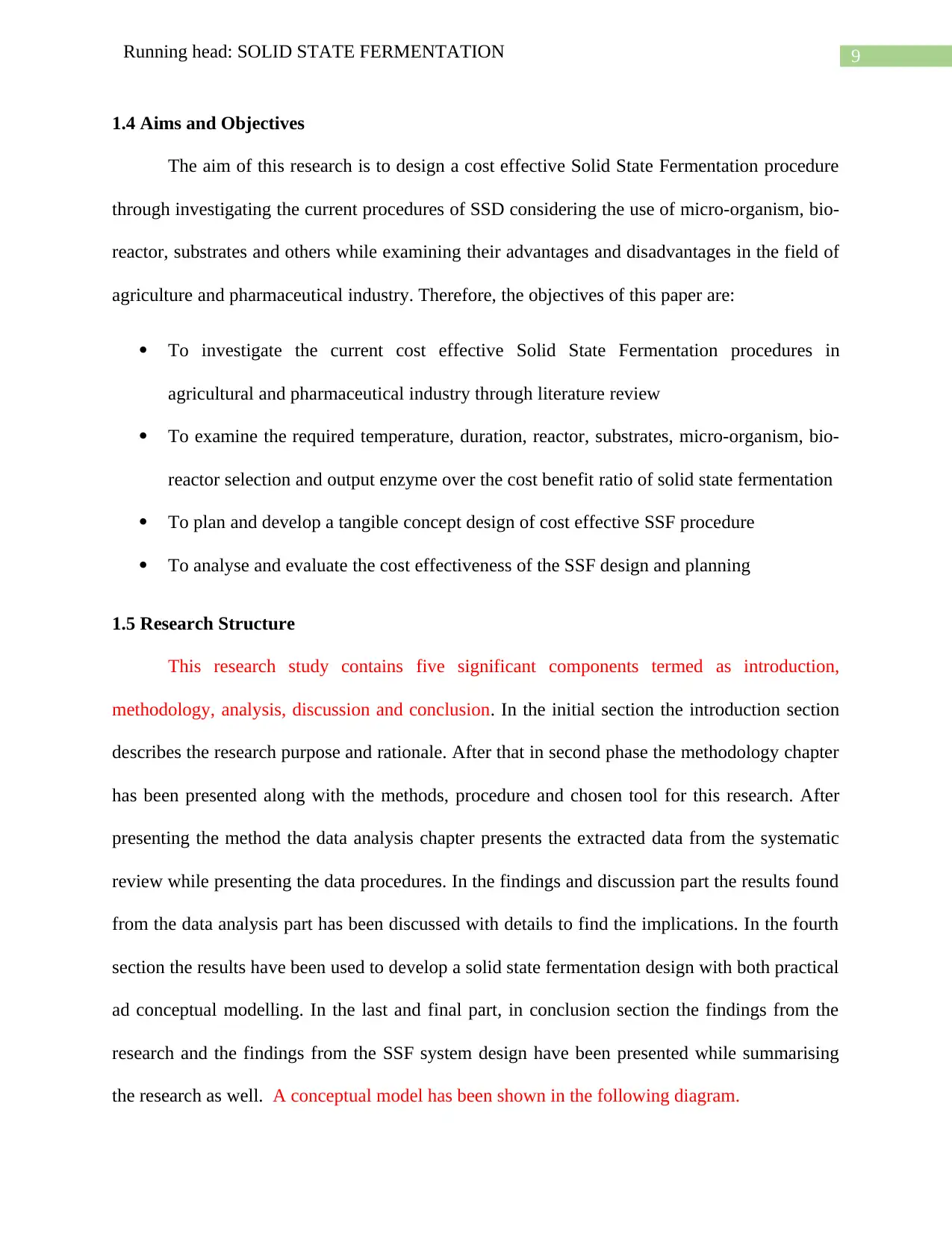
9Running head: SOLID STATE FERMENTATION
1.4 Aims and Objectives
The aim of this research is to design a cost effective Solid State Fermentation procedure
through investigating the current procedures of SSD considering the use of micro-organism, bio-
reactor, substrates and others while examining their advantages and disadvantages in the field of
agriculture and pharmaceutical industry. Therefore, the objectives of this paper are:
To investigate the current cost effective Solid State Fermentation procedures in
agricultural and pharmaceutical industry through literature review
To examine the required temperature, duration, reactor, substrates, micro-organism, bio-
reactor selection and output enzyme over the cost benefit ratio of solid state fermentation
To plan and develop a tangible concept design of cost effective SSF procedure
To analyse and evaluate the cost effectiveness of the SSF design and planning
1.5 Research Structure
This research study contains five significant components termed as introduction,
methodology, analysis, discussion and conclusion. In the initial section the introduction section
describes the research purpose and rationale. After that in second phase the methodology chapter
has been presented along with the methods, procedure and chosen tool for this research. After
presenting the method the data analysis chapter presents the extracted data from the systematic
review while presenting the data procedures. In the findings and discussion part the results found
from the data analysis part has been discussed with details to find the implications. In the fourth
section the results have been used to develop a solid state fermentation design with both practical
ad conceptual modelling. In the last and final part, in conclusion section the findings from the
research and the findings from the SSF system design have been presented while summarising
the research as well. A conceptual model has been shown in the following diagram.
1.4 Aims and Objectives
The aim of this research is to design a cost effective Solid State Fermentation procedure
through investigating the current procedures of SSD considering the use of micro-organism, bio-
reactor, substrates and others while examining their advantages and disadvantages in the field of
agriculture and pharmaceutical industry. Therefore, the objectives of this paper are:
To investigate the current cost effective Solid State Fermentation procedures in
agricultural and pharmaceutical industry through literature review
To examine the required temperature, duration, reactor, substrates, micro-organism, bio-
reactor selection and output enzyme over the cost benefit ratio of solid state fermentation
To plan and develop a tangible concept design of cost effective SSF procedure
To analyse and evaluate the cost effectiveness of the SSF design and planning
1.5 Research Structure
This research study contains five significant components termed as introduction,
methodology, analysis, discussion and conclusion. In the initial section the introduction section
describes the research purpose and rationale. After that in second phase the methodology chapter
has been presented along with the methods, procedure and chosen tool for this research. After
presenting the method the data analysis chapter presents the extracted data from the systematic
review while presenting the data procedures. In the findings and discussion part the results found
from the data analysis part has been discussed with details to find the implications. In the fourth
section the results have been used to develop a solid state fermentation design with both practical
ad conceptual modelling. In the last and final part, in conclusion section the findings from the
research and the findings from the SSF system design have been presented while summarising
the research as well. A conceptual model has been shown in the following diagram.
Paraphrase This Document
Need a fresh take? Get an instant paraphrase of this document with our AI Paraphraser
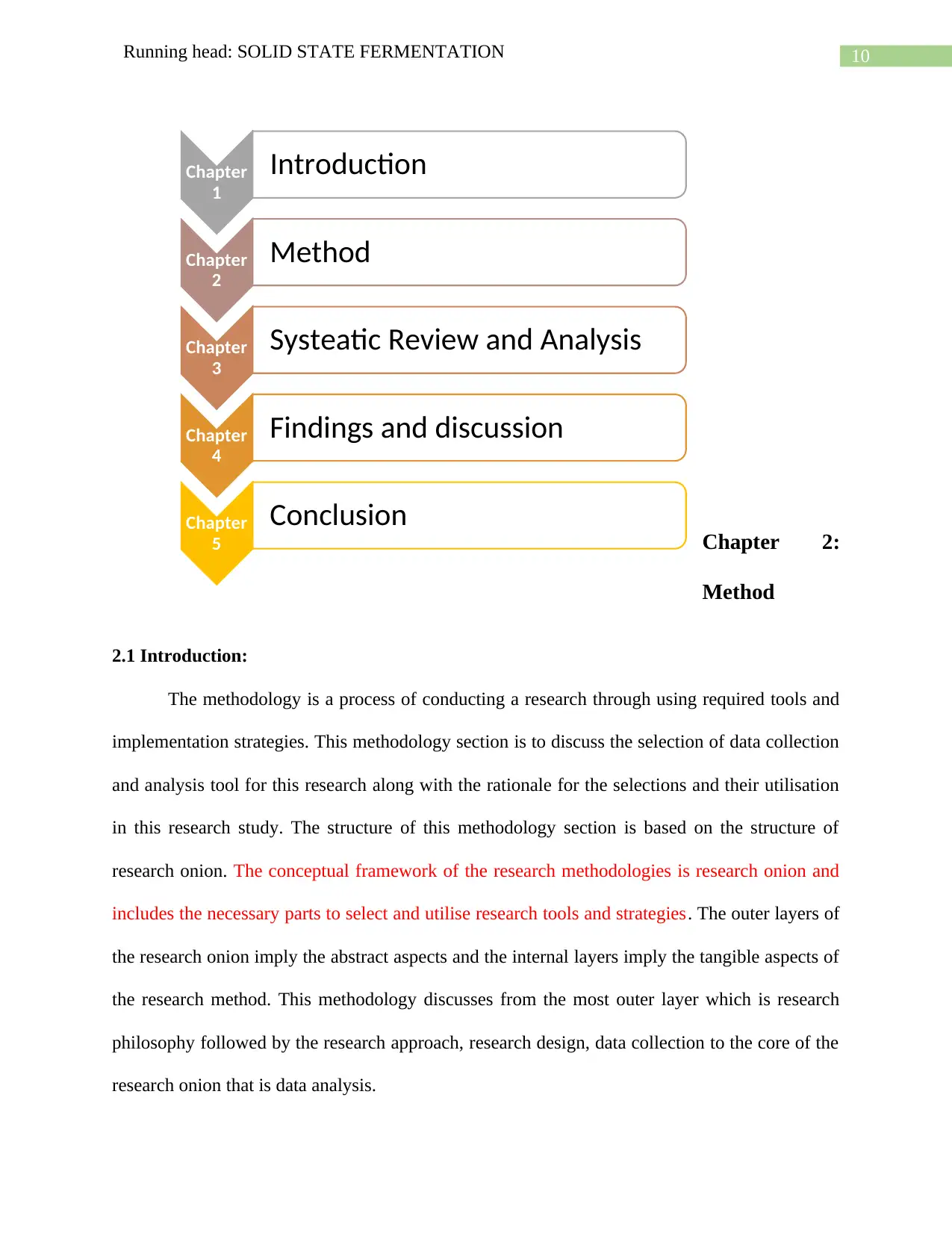
10Running head: SOLID STATE FERMENTATION
Chapter 2:
Method
2.1 Introduction:
The methodology is a process of conducting a research through using required tools and
implementation strategies. This methodology section is to discuss the selection of data collection
and analysis tool for this research along with the rationale for the selections and their utilisation
in this research study. The structure of this methodology section is based on the structure of
research onion. The conceptual framework of the research methodologies is research onion and
includes the necessary parts to select and utilise research tools and strategies. The outer layers of
the research onion imply the abstract aspects and the internal layers imply the tangible aspects of
the research method. This methodology discusses from the most outer layer which is research
philosophy followed by the research approach, research design, data collection to the core of the
research onion that is data analysis.
Chapter
1
Introduction
Chapter
2
Method
Chapter
3
Systeatic Review and Analysis
Chapter
4
Findings and discussion
Chapter
5
Conclusion
Chapter 2:
Method
2.1 Introduction:
The methodology is a process of conducting a research through using required tools and
implementation strategies. This methodology section is to discuss the selection of data collection
and analysis tool for this research along with the rationale for the selections and their utilisation
in this research study. The structure of this methodology section is based on the structure of
research onion. The conceptual framework of the research methodologies is research onion and
includes the necessary parts to select and utilise research tools and strategies. The outer layers of
the research onion imply the abstract aspects and the internal layers imply the tangible aspects of
the research method. This methodology discusses from the most outer layer which is research
philosophy followed by the research approach, research design, data collection to the core of the
research onion that is data analysis.
Chapter
1
Introduction
Chapter
2
Method
Chapter
3
Systeatic Review and Analysis
Chapter
4
Findings and discussion
Chapter
5
Conclusion
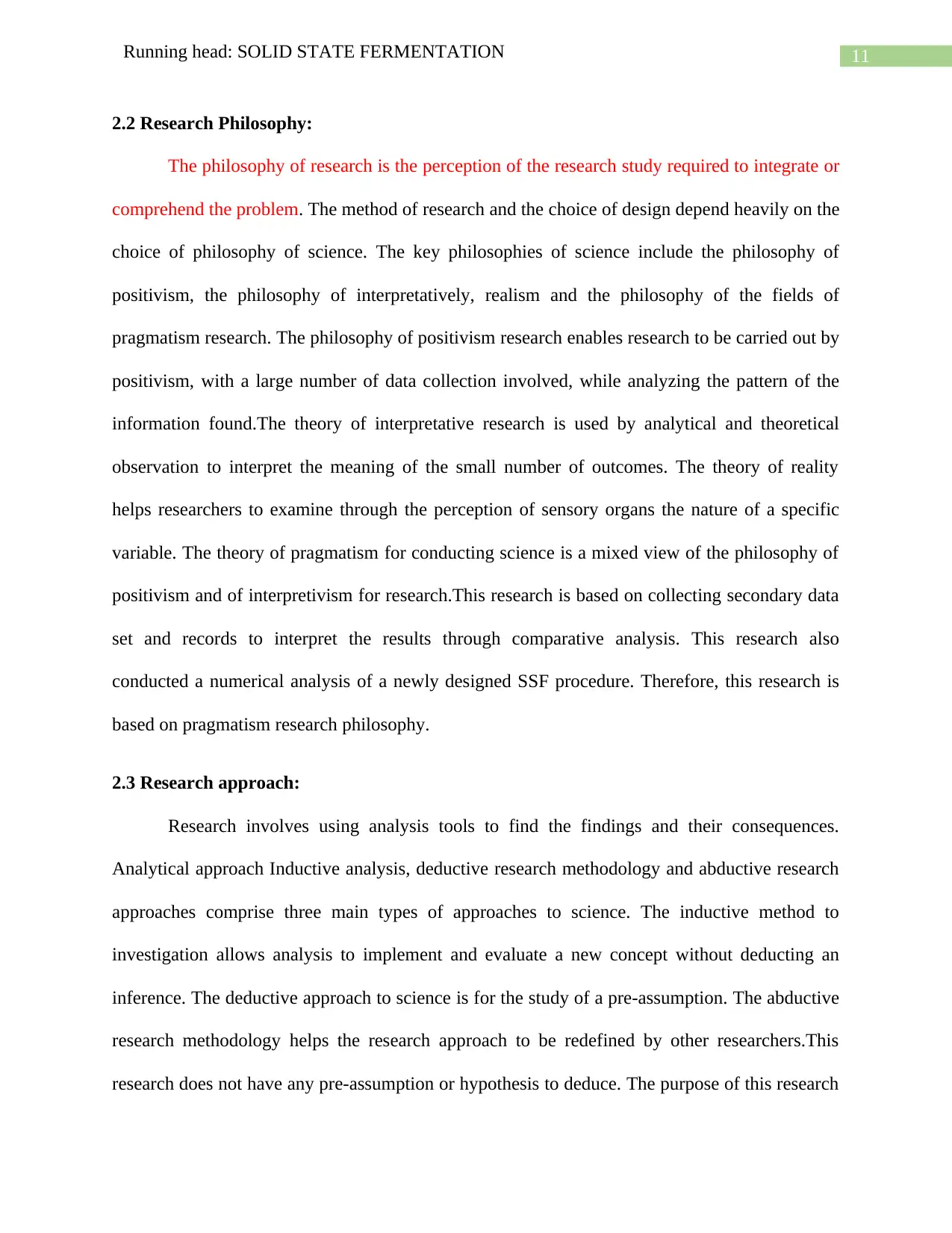
11Running head: SOLID STATE FERMENTATION
2.2 Research Philosophy:
The philosophy of research is the perception of the research study required to integrate or
comprehend the problem. The method of research and the choice of design depend heavily on the
choice of philosophy of science. The key philosophies of science include the philosophy of
positivism, the philosophy of interpretatively, realism and the philosophy of the fields of
pragmatism research. The philosophy of positivism research enables research to be carried out by
positivism, with a large number of data collection involved, while analyzing the pattern of the
information found.The theory of interpretative research is used by analytical and theoretical
observation to interpret the meaning of the small number of outcomes. The theory of reality
helps researchers to examine through the perception of sensory organs the nature of a specific
variable. The theory of pragmatism for conducting science is a mixed view of the philosophy of
positivism and of interpretivism for research.This research is based on collecting secondary data
set and records to interpret the results through comparative analysis. This research also
conducted a numerical analysis of a newly designed SSF procedure. Therefore, this research is
based on pragmatism research philosophy.
2.3 Research approach:
Research involves using analysis tools to find the findings and their consequences.
Analytical approach Inductive analysis, deductive research methodology and abductive research
approaches comprise three main types of approaches to science. The inductive method to
investigation allows analysis to implement and evaluate a new concept without deducting an
inference. The deductive approach to science is for the study of a pre-assumption. The abductive
research methodology helps the research approach to be redefined by other researchers.This
research does not have any pre-assumption or hypothesis to deduce. The purpose of this research
2.2 Research Philosophy:
The philosophy of research is the perception of the research study required to integrate or
comprehend the problem. The method of research and the choice of design depend heavily on the
choice of philosophy of science. The key philosophies of science include the philosophy of
positivism, the philosophy of interpretatively, realism and the philosophy of the fields of
pragmatism research. The philosophy of positivism research enables research to be carried out by
positivism, with a large number of data collection involved, while analyzing the pattern of the
information found.The theory of interpretative research is used by analytical and theoretical
observation to interpret the meaning of the small number of outcomes. The theory of reality
helps researchers to examine through the perception of sensory organs the nature of a specific
variable. The theory of pragmatism for conducting science is a mixed view of the philosophy of
positivism and of interpretivism for research.This research is based on collecting secondary data
set and records to interpret the results through comparative analysis. This research also
conducted a numerical analysis of a newly designed SSF procedure. Therefore, this research is
based on pragmatism research philosophy.
2.3 Research approach:
Research involves using analysis tools to find the findings and their consequences.
Analytical approach Inductive analysis, deductive research methodology and abductive research
approaches comprise three main types of approaches to science. The inductive method to
investigation allows analysis to implement and evaluate a new concept without deducting an
inference. The deductive approach to science is for the study of a pre-assumption. The abductive
research methodology helps the research approach to be redefined by other researchers.This
research does not have any pre-assumption or hypothesis to deduce. The purpose of this research
⊘ This is a preview!⊘
Do you want full access?
Subscribe today to unlock all pages.

Trusted by 1+ million students worldwide
1 out of 68
Your All-in-One AI-Powered Toolkit for Academic Success.
+13062052269
info@desklib.com
Available 24*7 on WhatsApp / Email
![[object Object]](/_next/static/media/star-bottom.7253800d.svg)
Unlock your academic potential
Copyright © 2020–2025 A2Z Services. All Rights Reserved. Developed and managed by ZUCOL.
